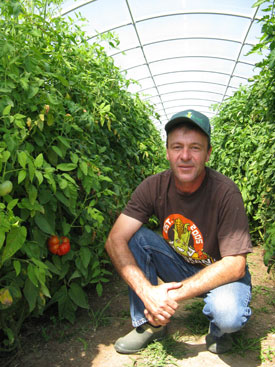Column: Seeds & Stems
Five years ago, Alex Young spent his days trying to get Zingerman’s Roadhouse up and open. A long-time chef, Young signed on as manager and chef there, moving his family to a farm outside Dexter.
But on his one day off each week, he picked up a shovel and started his garden. Every week, he dug one row, laboriously turning up deep layers of soil, trading physical labor for the stress of embarking on the new business venture.
That spring, Young wore out the heavy sole of his boot from the edge of the shovel and had a dozen rows in his 75-by-75-foot garden.
“It was a stress reducer,” he says now, and he still sees the calming and even meditative side of growing food as that garden sprouted into Cornman Farms, a business that still is growing.
As a chef, Young worked all over the country before moving with his family just down the road from the farm where his wife, Kelly, grew up. Now, from the deck of his home just outside Dexter, he can look out at acres of vegetables, as well as at the new barn, used mostly for storage and for spring plant propagation, and the hoop house, both built in the past few years.
In his life as a chef, Young, who has been nominated for a prestigious James Beard Award three years in a row, oversees operations at the Roadhouse, one of 10 businesses under the Zingerman’s umbrella. The restaurant emphasizes American food, and while fresh produce, cheese, meat and other items come from all over the United States, more and more appear from Young’s own growing farm.
He’s already had the first of four heirloom dinners – the next, on Aug. 25, will feature a tomato tasting, the last, on Nov. 11, will emphasize pickled produce, and Cornman Farms just happens to have rows of pickling cucumbers growing right now.
Though he knows he can’t really supply all the Roadhouse’s needs with his small operation, Young is hoping to maybe provide half of it.
At the farm now, you’ll find all the basics – garlic, beans, cucumbers, lettuce, squash – growing in the sandy loam soil, but basic to the farm are the native American crops: tomatoes, potatoes and corn.

Alex Young, chef of Zingerman's Roadhouse, in a hoop house at his farm near Dexter, where he grows heirloom tomatoes. He's wearing a Cornman Farms T-shirt. (Photo by the writer.)
There are eight or nine varieties of tomatoes in the fields at Cornman Farms, but heirloom tomatoes dominate the 92-by-30-foot hoop house. The structure, built two years ago, has a shape akin to World War II Quonset huts, but instead of a covering of metal plates, it’s covered in plastic, which catches and holds the warmth from even a weak spring sun to give plants an early start.
In the case of Cornman Farms’ hoop house, young plants also are helped by a radiant heating system installed in the ground. To regulate the warmth in the hot months, the lower part of the plastic wall can be raised to provide a little cooling cross-ventilation. Young would like to add solar heat, and maybe expand by adding two more hoop houses.
This season, the hoop house incubated a number of tomato varieties, including Mortgage Lifter, Brandywine and Valencia – some of them so tall they needed to be topped off.
Mark Baerwolf, the farm’s full-time manager, says that’s a good thing at this time of year. It will take at least two months for any new fruit to ripen – maybe more, given the cooler and shorter days of fall – so when you see newly blooming flowers in August, you can be pretty sure they’re not going to produce any ripe tomatoes. Pruning them just lets the plant direct its energy to the tomatoes that are already on the vine.
Overall, the farm produced about 18,000 pounds of tomatoes last year, and is planning on about 23,000 pounds this year, Young estimates.
Heirloom potatoes are planted in a nearby field, arranged according to when they’re ready to be harvested, from the early Red Gold and knobby Irish Cobbler, through the Green Mountain, Bintje and German Butterball, to the Kennebec and Russell Burbank varieties.
The potatoes currently take up an acre lent to Cornman Farms by Young’s neighbor. Next year, Young plans to grow about four acres of potatoes on part of the 100 acres he rents from another farmer nearby. His goal is to have at least 10 acres of potatos, his estimate of what the Roadhouse needs each year.
“It will take a few years to get there,” says Young, “but I will.”
A farm named Cornman has got to be growing some corn, and there is a yellow variety, Henry Moore, growing along with winter wheat and a red bean variety “Merlot,” on part of a rented field a few miles away.
But outside his house, Young is trying out a patch of hard-to-get red Trentino flint corn, an heirloom variety from Italy, hoping the deer won’t bust in for a taste before it’s ready.
There haven’t been any total crop failures, says Baerwolf, though there have been some vegetables that were disappointments. Both the sweet potatoes and the Moon and Stars watermelons grew all right, but they needed a longer season to be at their best, he says. That just means that they should be started early in the season in the farm’s hoop house to give them lots of time to ripen.
Baerwolf was a line cook at the Roadhouse when he started spending half his time each week working at the farm three summers ago.
“Everything I was growing was showing up (at the Roadhouse),” he says.
The number of hours he spent at the farm grew, and now he’s there full-time, along with two seasonal employees. Once a month, a group of Roadhouse employees come out to do a little work and get lunch on the deck. Sometimes, says Young, some of his good customers come out to the farm and help with jobs like gathering potatoes.
Cornman Farms isn’t a certified organic operation, a designation that requires a long process, but it’s the kind of place where they use compost tea – made by steeping a bag of compost in water before spraying the mixture onto the plant – instead of chemical fertilizers.
They’ll even use food scraps from the Roadhouse to make their compost, says Baerwolf.
Young sees his farm as an alternative to the food industry’s agricultural methods, where human hands may never even touch crops growing in the field. It’s an idea that seems to be catching on, with recent books and movies that show the often unappetizing ways much of our food is now produced.
Still, when it’s cheaper to buy a $3.99 burger from MacDonald’s than the Roadhouse’s macaroni and cheese for $13.50, what’s a better deal?
Young will say it’s the mac and cheese – which is made with handmade cheddar and pasta from Italy – because though you might pay less money for industrial ground beef at a fast food outlet, you’re not looking at the true costs, such as the toll on your health, on the welfare of animals or on the agricultural environment.
While he was at the Washtenaw County 4-H Youth Show last month, Young was taken by a bumper sticker that read, “No farms, no food,” though he might change it a little to reflect his support of many smaller farms over massive agricultural conglomerates.
“I’m thinking there should be another one: ‘More Farms, Better Food,’” he says.
About the writer: Marianne Rzepka, former reporter for the Ann Arbor News and Detroit Free Press, is a Master Gardener who lives in Ann Arbor and thinks it’s fun to turn the compost pile.





Great article, Marianne. I, too, am a believer in the turning-soil-as-therapy model. And I’d buy one of those bumper stickers as well.
Marianne – how great to see your photo and story! I still go out to the curb everyday expecting to see the paper there – glad I found you here!
And kudos to the Chef and Zingerman’s for supporting the community with great ideas and food that make a difference!
Glad to see one photo of the farm was included besides the main photo of the jouralnist. More photos are more interesting.
Marianne,
Happy to see that you’re back at the keyboard. Always enjoy your local observations and stories. Hoping to run into you at the Farmers’ Market again before too awfully long.
Regards,
-Prue